[Emulate] Refinement of Computation and Communication
- Refinement of Computation and Communication
Refinement of Computation and Communication1
Introduction
Communication Refinement
- Expand an abstract communication into an actual implementation
- Example: transition from
sc_fifotohw_fifo - Implementation can be either software or hardware
- Hardware: a shift register or a RAM with some control logic
- Software: a certain memory range with a modulo addressing scheme
- Example: transition from
- No simple one-size-fits-all approach
- Key principles
- Use well-defined and well-understood interfaces
- Intelligent use and reuse of adapters and converters
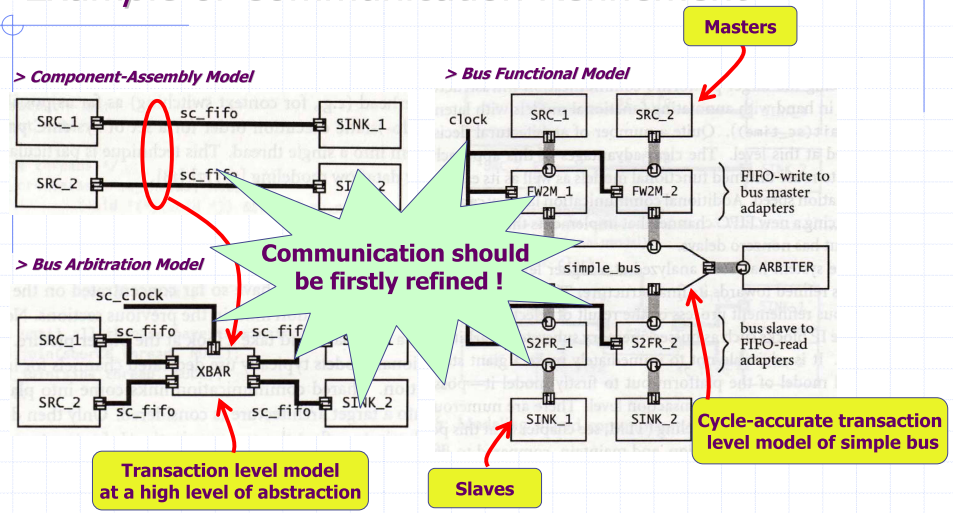
Steps in Communication Refinement(Important)
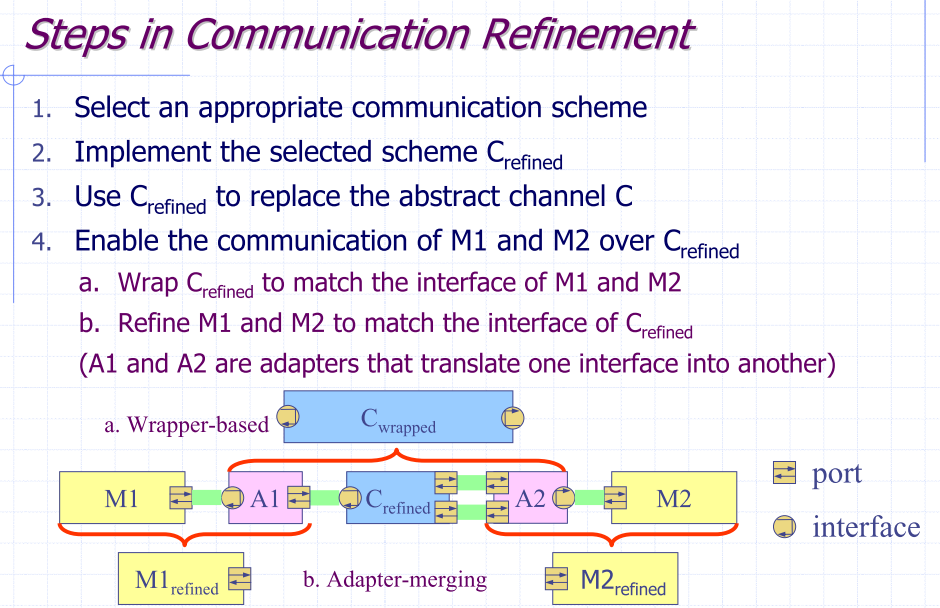
Adapters – Channel Refinement
- A hierarchical channel that translates the interface it implements into port accesses bound to a different interface
- Example: the
read()/write()methods in thehw_fifo_wrappercan be encapsulated in an adapter, respectively
- Example: the
- Adapters can be easily reused and a small library of adapters is sufficient
- Typically only a finite number of different interfaces are used
- Two things that can be done with an adapter for refinement
- Introduce an additional level of hierarchy
- Wrap the refined channel and the adapters connected to it
- Merge the adapters into the calling modules
- Move ports, processes, methods, and data fields to the calling processes
- Replace calls to the adapter’s methods with the new member functions
- Introduce an additional level of hierarchy
Converters – Module Refinement
- A module that translates a set of ports to another in order to make the refined module and communication channel fit together
- The refined model could be a piece of an existing IP and have a different set of ports than its abstract counterpart
- Things that can be done with an converter for refinement
- Wrap a refined module and a converter as a new module that matches the channel’s footprint
- Merge an adapter to form a new, refined converter
- A converter may accesses an adapter via the adapter’s interface
- Converters versus Adapters
- Converters tend to be a component in the final implementation
- Adapters are often temporal objects
General Process of Refinement(Important)
- Select and Replace
- Select a refined implementation for a component
- Replace the original component with the refined implementation
- Insert adapters or converters (optional)
- Make channel and module play together
- Adapters and converters should be stored in an accessible library
- Analyze the I/O functionality and performance
- Verify the functionality and system performance
- Flatten (optional)
- Ungroup the hierarchy of the wrapped channel
- Merge adapters and connected modules
- Wrap (optional)
- Wrap the refined channel and the set of connected adapters to create a new channel for software implementation
- Merge (optional)
- Refine an abstract communication protocol (transaction-level) towards a hardware implementation (pin-level)
- Merge adapters into the calling modules (protocol inline)
- Restructure control flow (optional)
- High level module is generally described in a sequential manner using blocking
read()/write()- first_output->write(some_data)
- second_output->write(some_data)
- Sequential execution might not be suited for hardware
- One may want to refine control flow to exploit more parallelism
- first_output->initiate_transmission(some_data)
- second_output->initiate_transmission(some_data)
- wait_for_completion(first_port, second_port)
- High level module is generally described in a sequential manner using blocking
- Analyze Implementation
- Check both functionality and I/O performance
- Analyze the partial or entire system for its implementation characteristics such as area, latency, clock frequency, and power dissipation
Hardware-Hardware Communication Refinement (From Abstract Model to RTL)
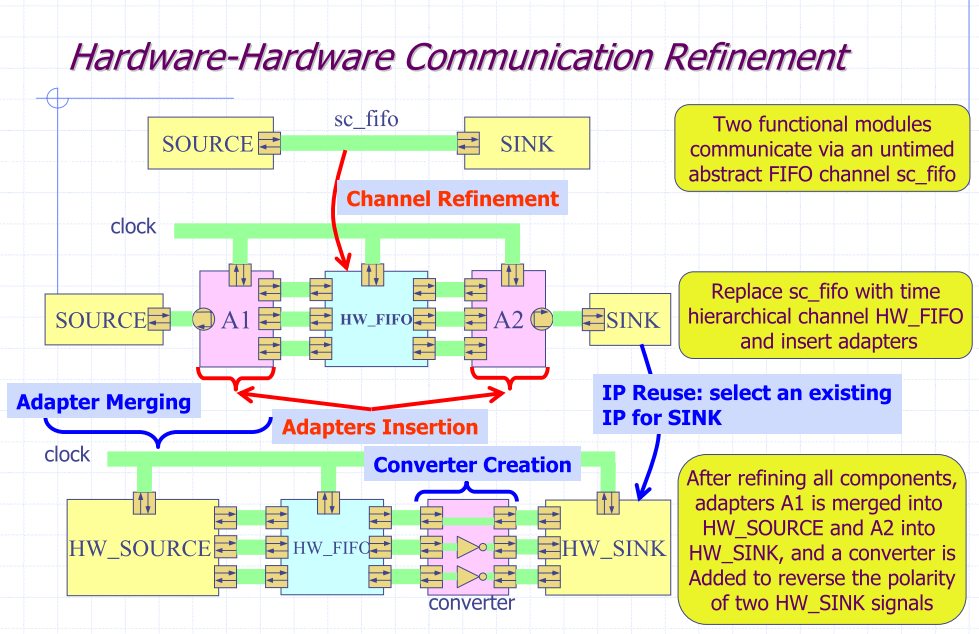
Implementation of Adapters
Source Codes
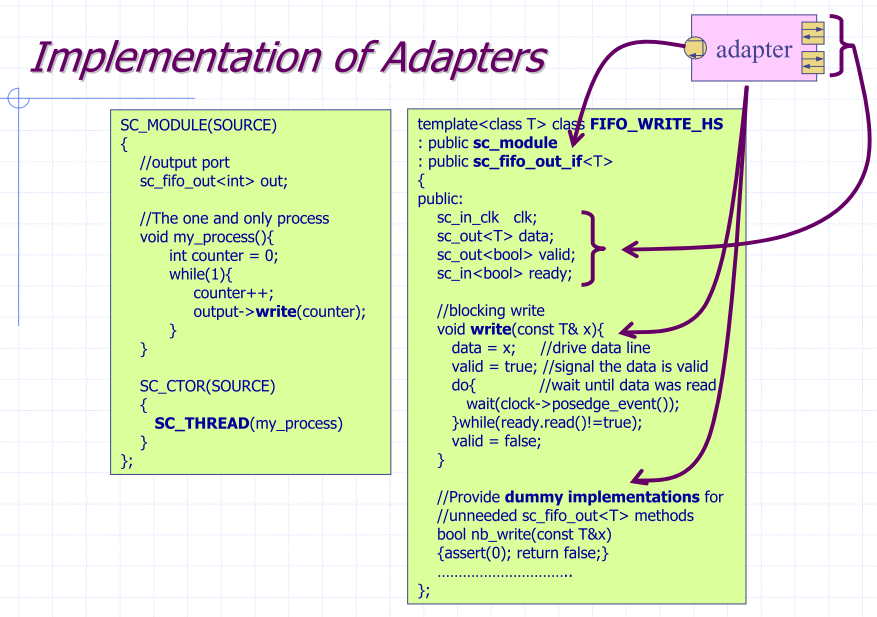
SC_MODULE(SOURCE)
{
//output port
sc_fifo_out<int> out;
//The one and only process
void my_process(){
int counter = 0;
while(1){
counter++;
output->write(counter);
}
}
C_CTOR(SOURCE)
{
SC_THREAD(my_process)
}
};
template<class T> class FIFO_WRITE_HS
: public sc_module
: public sc_fifo_out_if<T>
{
public:
sc_in_clk clk;
sc_out<T> data;
sc_out<bool> valid;
sc_in<bool> ready;
//blocking write
void write(const T& x){
data = x;//drive data line
valid = true; //signal the data is valid
do{ //wait until data was read
wait(clock->posedge_event());
}while(ready.read()!=true);
valid = false;
}
//Provide dummy implementations for
//unneeded sc_fifo_out<T> methods
bool nb_write(const T&x)
{assert(0); return false;}
…………………………
};
Merging Adapters
- Goal
- To merge the adapters into the calling module for “protocol inline”
- The result is a refined pin-level module
- Procedures (Important)
- Copy and paste the adapter’s properties into the calling module
- Ports, methods, data fields, and processes
- Care must be taken to avoid name clash
- Remove the original port that was used to access the adapter
- Replace the template argument T with the actual data type
- Create methods and constructors of the calling module
- The adapter’s methods become new methods of the calling module
- The adapter’s constructor must be merged into the calling module’s constructor
- If the adapter has additional constructor arguments, these can usually be replaced with constant expressions
- Replace references to the adapter’s clock with accesses to the calling module’s clock
- Copy and paste the adapter’s properties into the calling module
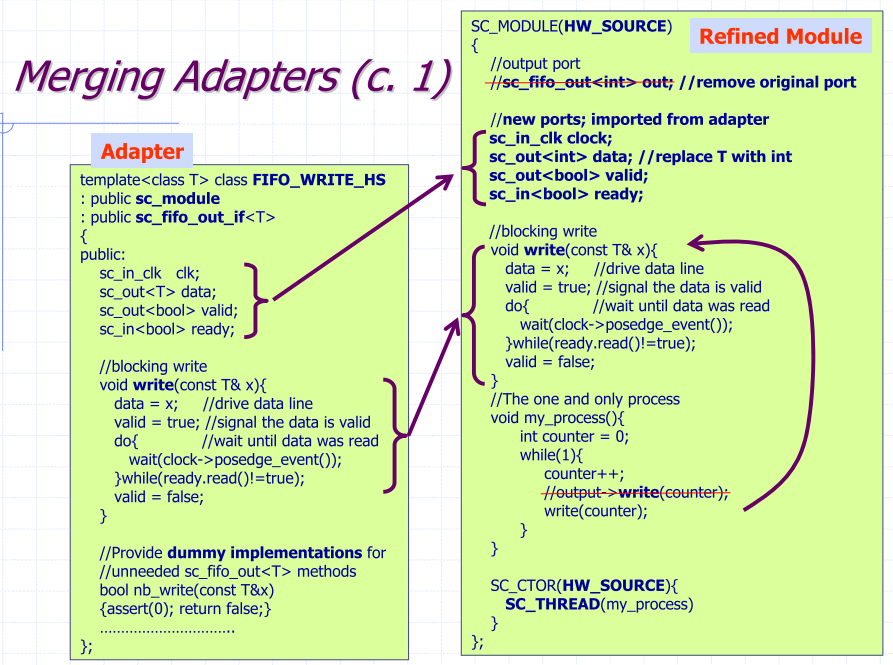
Implementation of Converters
Assume we select an existing IP HW_SINK for the SINK module
- The IP has active low on the pins valid and ready
- A converter is used to reverse the polarity of the “valid” and “ready”
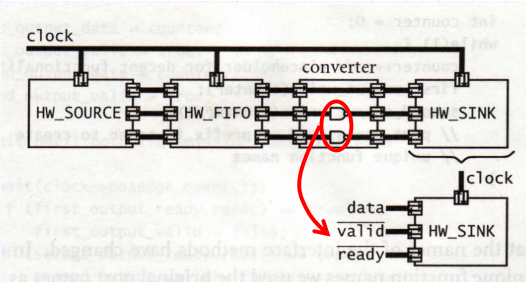
Control Flow Restructuring
- One should use
forkandjoinconstructs to model parallel implementation for design space exploration - Restructure the control flow if the results look encouraging
Source Codes
void HW_SOURCE::my_process(){
int counter = 0;
while(1){
counter++;
first_output_data = counter;
first_output_valid = true;
second_output_data = counter/2;
second_output_valid = true;
do{
wait(clock->posedge_event());
if(first_output_ready.read()==true)
first_output_valid = false;
if(second_output_ready.read()==true)
second_output_valid = false;
}while(!(first_output_ready.read() && second_output_ready.read()));
}
}
Software-Software Communication Refinement (From SystemC to Plain C)
- Refine SystemC models towards software implementations
- Map the SystemC model into software implementation
- Convert the SystemC design into C++ or even C codes
- Get rid of SystemC elements
- OS support is required for mapping the SystemC processes into concurrent threads
- Refinement process is architecture- and OS-dependent
- Primitive elements of software-based communication
- Memory and a set of access methods
- Inter-process synchronization primitives offered by the OS
- Primitive elements of software-based communication
- Support for modeling software running on the RTOS will be improved in future versions of SystemC
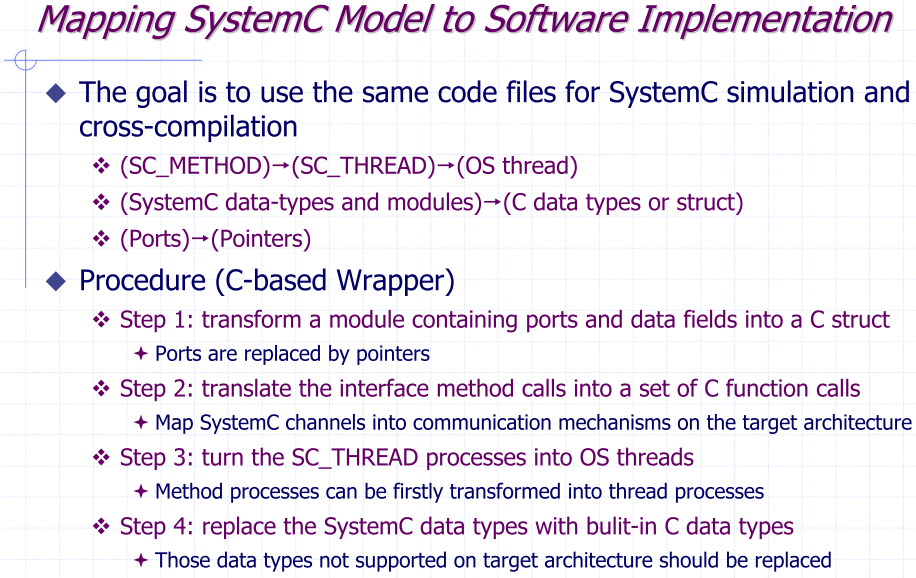
Hardware-Software Communication Refinement
- Hardware Part: From Abstract Model to RTL
- Software Part: From SystemC to Plain C
Communication refinement: XBAR
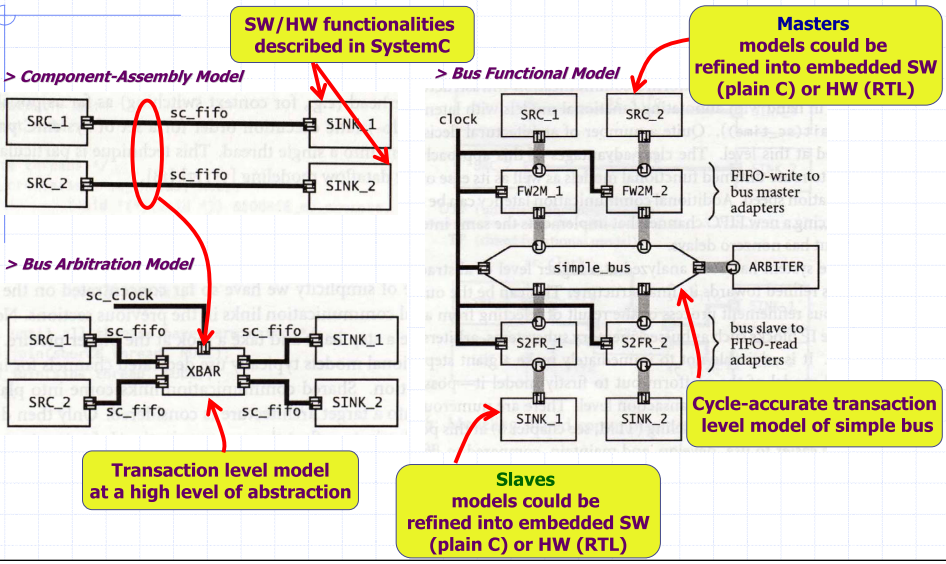
Implementation of XBAR
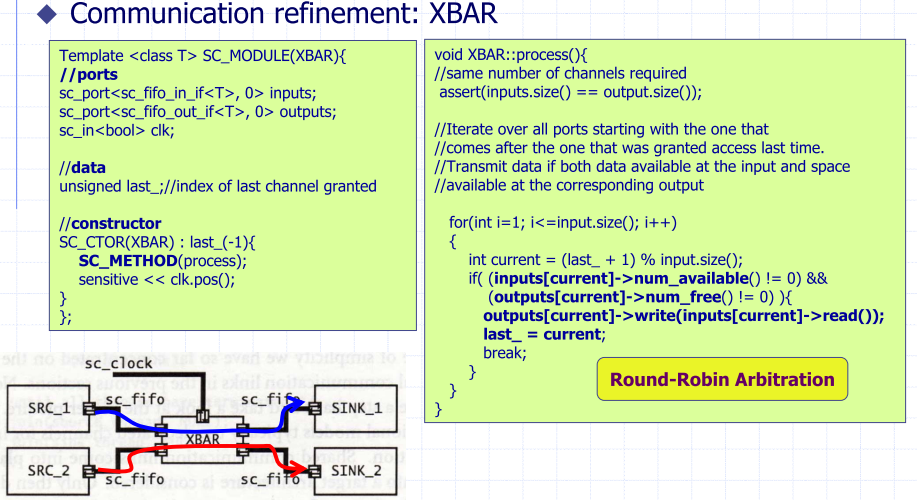
What Are to Be Explored?
- Interconnect topology between modules
- Hub and spoke architecture
- Cross bar switch
- Arbitration policy and prioritized accesses
- FIFO sizes associated with each module
- Resource locking
- Wait states
- Timing and performance
- ……..
Platform Refinement
Hardware Part
- The platform is refined after the system has been analyzed at a higher level of abstraction
- A continuous refinement process
- Selection from a number of available IP blocks
- Busses, memory sub-system, arbiters, bridges, and so on
- It is advisable not to make a giant step towards a pin-level model
- Model the platform - possibly in a cycle-accurate way - at the transaction level
- What are to be explored?
- The number of buses
- The features of the buses
- Connection topology
- Decision of master and slave
- Modes of transmission
- Send data immediately by a single read/write
- Cache data and send it as a burst read/write
- Initiate a split transaction (slave)
- Burst length in case of burst read/write
- Bus arbitration policy
- Software/Firmware/Hardware implementation
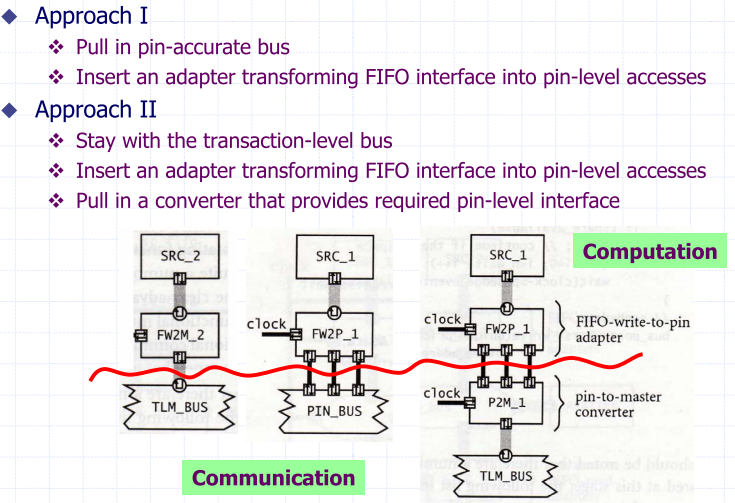
Software Part
- Refine the software down to the bus transaction level
- Make sure the software will interact properly with the hardware
-
IOC5080(5940) System Model Design and Verification, Department of Computer Science, National Chiao-Tung University ↩